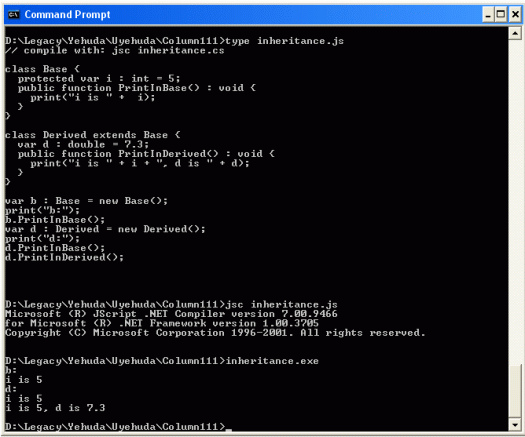JScript .NET, Part V: Polymorphism: Using Derived Objects with Base Methods - Doc JavaScript
JScript .NET, Part V: Polymorphism
Using Derived Objects with Base Methods
Let's recap inheritance with an example. It has two classes, Base and Derived. The Base class has one property (an integer, i) and one method, PrintInBase(). The Derived class has one property as well (a double, d), and one method, PrintInDerived().
The main code in JScript .NET is not delimited in any way. You just write the code outside; before, after, or in between the class definitions. The main code in our example allocates two objects, b of type Base and d of type Derived. We first apply the Base method (PrintInBase) to b. We then apply both the Base method and the Derived method to d. You can see below that the derived object refers to its base class, and can use the base method. In fact, a derived object can refer to any of its base classes. Here is the code:
// compile with: jsc inheritance.js class Base { protected var i : int = 5; public function PrintInBase() : void { print("i is " + i); } } class Derived extends Base { var d : double = 7.3; public function PrintInDerived() : void { print("i is " + i + ", d is " + d); } } var b : Base = new Base(); print("b:"); b.PrintInBase(); var d : Derived = new Derived(); print("d:"); d.PrintInBase(); d.PrintInDerived();
Here is a capture of the command prompt window. It shows the code, inheritance.js, the messages of the jsc compiler, and the output of the executable, inheritance.exe:

Next: How to use the .NET framework polymorphic methods
Produced by Yehuda Shiran and Tomer Shiran
All Rights Reserved. Legal Notices.
Created: June 3, 2002
Revised: June 3, 2002
URL: https://www.webreference.com/js/column111/3.html


 Find a programming school near you
Find a programming school near you